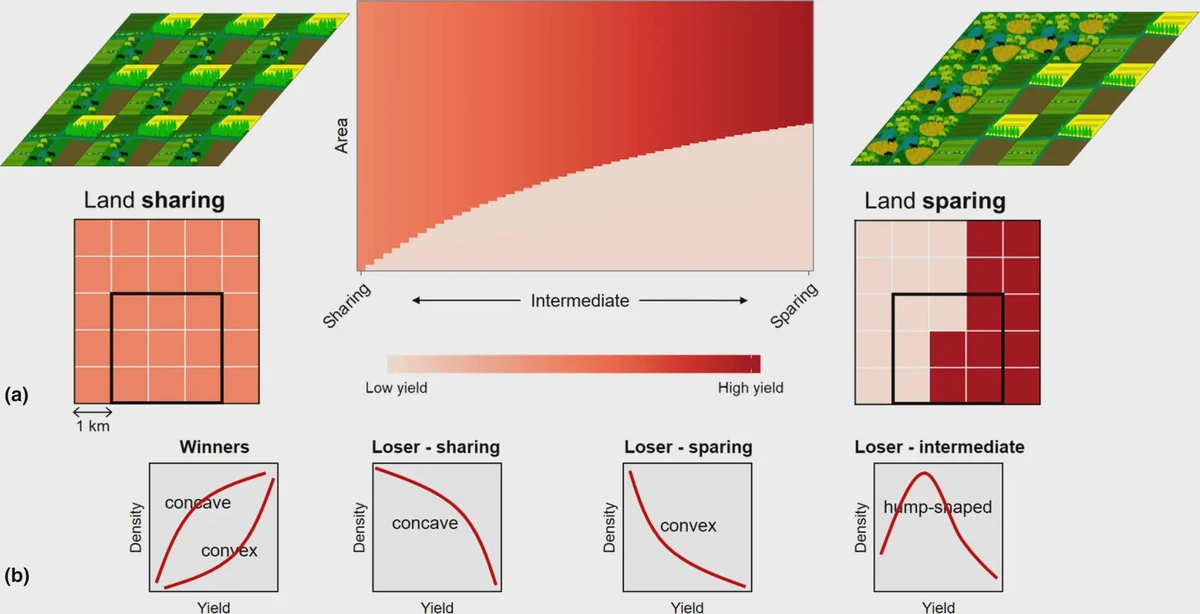Journal article: ‘Sustainable intensification’
Journal article: ‘Sustainable intensification’ — Why high-yield farming may offer best solution to meet ecological and consumption demands


How to feed, house, clothe and power 11 billion of us without eliminating very many species and wrecking Earth’s climate is perhaps this century’s greatest challenge.
We must obviously strive to curb growth in resource-intensive demand, but we also need to identify production systems that meet people’s needs at least overall cost to nature.
The land-sharing/sparing concept provides a quantitative framework for doing this, centred around the principle that generating meaningful insights requires comparing alternatives that are matched in terms of overall production.
Applications of this framework to >2500 individually assessed species of vertebrates, plants and insects across five continents show that most species decline under farming, and that most would fare least badly under a land-sparing approach – with high-yield production meeting demand in a relatively small, farmed area, freeing-up space for conservation of intact habitats elsewhere in the landscape.
However, important questions remain around how to deliver high yields sustainably, and how to ensure high-yield farming does indeed spare natural habitat.
The framework is increasingly being applied in other domains too – including urban planning, recreation, forestry and fisheries – where it has the potential to shed light on long-running debates about whether nature would prefer us to concentrate our impact or spread it more lightly but widely.
There are clearly many questions left to answer. Nevertheless empirical data from sharing/sparing studies in agriculture, in forestry, in urban planning and even in nature-based recreation repeatedly show that very many species – and certainly the majority of those that are specialized or narrowly distributed – are strongly dependent on the continued retention of relatively large areas of natural habitat.
Natural vegetation too is clearly of disproportionate value in sequestering and storing carbon. Giving rising human demands, keeping extensive areas free from the cow, the plough and the chainsaw will require increasing yields elsewhere, and will thus diminish the value of areas of production for other species and for ecosystem services.

This is an excerpt. Read the original post here.

 | Videos | More... |

Video: Nuclear energy will destroy us? Global warming is an existential threat? Chemicals are massacring bees? Donate to the Green Industrial Complex!
 | Bees & Pollinators | More... |

GLP podcast: Science journalism is a mess. Here’s how to fix it

Mosquito massacre: Can we safely tackle malaria with a CRISPR gene drive?

Are we facing an ‘Insect Apocalypse’ caused by ‘intensive, industrial’ farming and agricultural chemicals? The media say yes; Science says ‘no’
 | Infographics | More... |

Infographic: Global regulatory and health research agencies on whether glyphosate causes cancer
 | GMO FAQs | More... |

Why is there controversy over GMO foods but not GMO drugs?

How are GMOs labeled around the world?

How does genetic engineering differ from conventional breeding?
 | GLP Profiles | More... |

Alex Jones: Right-wing conspiracy theorist stokes fear of GMOs, pesticides to sell ‘health supplements’




 Viewpoint — Fact checking MAHA mythmakers: How wellness influencers and RFK, Jr. undermine American science and health
Viewpoint — Fact checking MAHA mythmakers: How wellness influencers and RFK, Jr. undermine American science and health Viewpoint: Video — Big Solar is gobbling up productive agricultural land and hurting farmers yet providing little energy or sustainabilty gains
Viewpoint: Video — Big Solar is gobbling up productive agricultural land and hurting farmers yet providing little energy or sustainabilty gains Trust issues: What happens when therapists use ChatGPT?
Trust issues: What happens when therapists use ChatGPT? Fighting deforestation with CO2: Biotechnology breakthrough creates sustainable palm oil alternative for cosmetics
Fighting deforestation with CO2: Biotechnology breakthrough creates sustainable palm oil alternative for cosmetics California, Washington, Oregon forge immunization alliance to safeguard vaccine access against federal undermining
California, Washington, Oregon forge immunization alliance to safeguard vaccine access against federal undermining 30-year-old tomato line shows genetic resistance to devastating virus
30-year-old tomato line shows genetic resistance to devastating virus The free-range chicken dilemma: Better for birds, but with substantial costs
The free-range chicken dilemma: Better for birds, but with substantial costs ‘You have to treat the brain first’: Rethinking chronic pain with Sanjay Gupta
‘You have to treat the brain first’: Rethinking chronic pain with Sanjay Gupta
